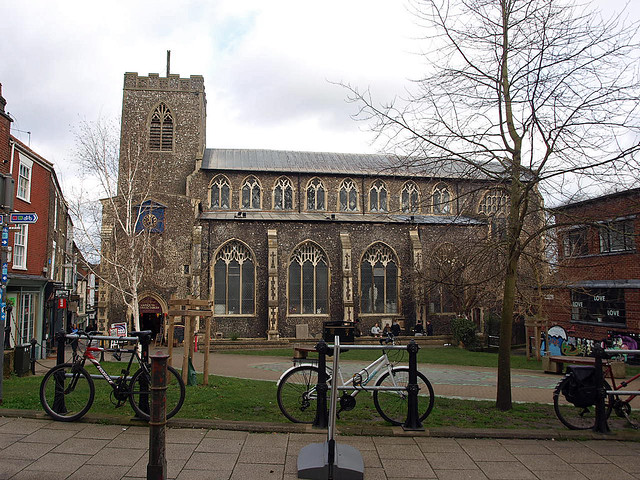ST GREGORY, Pottergate. W tower tall, with flushwork-panelled battlements. The spire was demolished in 1840. W doorway inside a shallow little porch with a quadripartite vault. The doorway has panelling up one moulding of jambs and arch. All windows in the body of the church Perp with two-centred arches. The arcade piers (four-bay arcades) indicate a date between Dec and Perp: four strong shafts and eight very thin ones in the diagonals. Castellated polygonal capitals. Two-centred arches. The clerestory, with eight closely set windows, concurs. The window tracery is still Dec. Two two-storeyed porches, attached to the W walls of the S and N aisles. The S porch has two bays of quadripartite vaulting with ridge-ribs and bosses. Niche above the entrance. The N porch is simpler. The chancel projects one bay beyond the aisles. Very tall windows. The chancel was rebuilt in 1394 at the expense of the Cathedral Priory. A passage runs from N to S under the chancel (cf. St Peter Mancroft). The most enjoyable feature of the interior is the inside of the tower. There is a vault high up and a stone gallery looks down whose underside is also vaulted. Both vaults are tierceron-stars, with two pairs of tiercerons and a big bell-hole, but the upper one has strictly speaking no diagonal ribs. Instead three ribs rise from the corners; they are then cut off by a diagonal, and the rest of the vault is continued from there. Traceried STOUP under the tower. - FONT. At the foot four rather alarming, grotesque busts and four lions’ heads. Against the bowl shields in cusped fields. - FONT COVER. Jacobean. Low with volutes. - SCREEN. Only two and a half panels of the dado remain; with painted figures. - STALLS. Four in the chancel. The MISERICORDS have a lion, two angels, and a bearded man. - Eagle LECTERN of brass, East Anglian, dated 1496. It belongs to the same type as the lecterns of Oxborough, Lowestoft, Oundle, and also Holy Trinity Coventry, St Michael Southampton, Southwell and Newcastle Cathedrals, and Urbino Cathedral. - DOOR-KNOCKER. Now in the S chapel. An outstandingly good piece of the C14 with a lion’s head devouring a man. - WALLPAINTING. Large, N aisle W. It represents St George, dates from the mid C15, and is in an unusually good state. - STAINED GLASS. A few bits in a N aisle window. - TEXTILES. C16 pall with the repeating motifs of an angel holding a soul in a napkin and a dolphin. - Also an earlier piece of a cope. - PLATE. Chalice and Paten (London) 1609-10; Flagon (Norwich) 1627-8. - MONUMENTS. Francis Bacon, 1659. Big tomb-chest (S chapel). - Sir Joseph Payne d. 1668. Tablet with a broad frame illustrating military equipment. Compact garland below the open segmental top (chancel N). - Sir Peter Seaman d. 1715. By Thomas Green of Camberwell. Demi-figure in a niche pointing forward with a baton. Putti l. and r. (N chapel). - Joseph Chamberlin d. 1762 by Thomas Ivory. In an elegant architectural frame (nave W). - Several more good Georgian tablets.
St Gregory’s (the third of the four important churches near the marketplace), comes chiefly from the end of the 14th century. The platform of the altar is raised ten steps above the floor of the nave, and has an arched vault beneath it. The porch of the tower has a vault with fine bosses, and from it we look through the lacy veil of birch trees in the tiny square to the tower of the City Hall. The church tower has beautiful vaulting; and the clustered pillars of the high arcades have embattled capitals. There is part of a worn pall of crimson velvet, and another old pall embroidered with a design of angels and fishes. Old woodwork is seen in four stalls with carved arm-rests and misereres, and a fragment of the screen has paintings of saints and an angel, one being Barbara with her tower. A reminder of the days when members of the Guild of St George worshipped here is the great wall painting in the north aisle, showing St George fighting the dragon while the princess stands by and the king and queen look on from a high tower. A great treasure is a brass eagle lectern with three lions at the foot, for it is dated 1493, and is one of about 50 old ones left in England*. Another treasure is the brass escutcheon now on the vestry door, its old ring gone; it is the head of a lion with a man’s head in its mouth, set in a border of trailing leaves, and fashioned in the 14th century. Shields and angels adorn the splendid 15th-century font which stands on the heads of four lions and four men. Sir Francis Bacon, who gave money for the repair of the font, has a huge altar tomb. He was one of the judges who resigned after the death of Charles Stuart rather than take the oath in the name of the people instead of in the name of the king.
* Now in St Giles on the Hill.

No comments:
Post a Comment